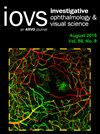Administration of Nicotine Can Inhibit Myopic Growth in Animal Models.
IF 5
2区 医学
Q1 OPHTHALMOLOGY
引用次数: 0
Abstract
Purpose While previously investigating the mechanism by which atropine inhibits ocular growth, we observed that stimulation of nicotinic receptors can inhibit experimental myopia. This study expands on that preliminary finding and investigates the safety and efficacy of nicotinic stimulation in the inhibition of ocular growth. Methods Nicotine's ability to inhibit form-deprivation myopia (FDM), following intravitreal injection (9 chicks per group) or topical application (6 chicks per group), was investigated over three doses. The ability of nicotine to inhibit lens-induced myopia (LIM) was also tested (in 12 chicks). For ocular safety, following 4 weeks of topical treatment with nicotine (n = 10), pupillary reflex, intraocular pressure, corneal curvature/thickness, lens thickness, retinal health (retinal thickness/cell apoptosis), as well as retinal function (electroretinogram recordings) were assessed. We also examined the effects of nicotine on non-ocular autonomic functions in both chicks (n = 5) and mice (n = 5). Results Nicotine was observed to significantly inhibit the development of FDM in chicks when administered as an intravitreal injection (P < 0.05) or topical eye drops (P < 0.05), albeit not in a dose-dependent manner. Nicotine also inhibited LIM (P < 0.05) to a similar degree to that seen for FDM. Although ocular health was (for the most part) unaffected by nicotine, the highest topical dose induced a temporary reduction in cardiorespiratory output (P < 0.05). Conclusions Nicotine, administered as an intravitreal injection or topical eye drop, significantly inhibits the development of experimental myopia. Although the anti-myopic effects observed presently are interesting, the well-reported side effects (expanded on presently) and addictive properties of nicotine would preclude its clinical use.尼古丁能抑制动物模型的近视增长
目的在研究阿托品抑制眼球增长的机制时,我们发现刺激烟碱受体可以抑制实验性近视。方法研究了尼古丁在玻璃体内注射(每组 9 只小鸡)或局部涂抹(每组 6 只小鸡)三种剂量后抑制形觉剥夺性近视(FDM)的能力。此外,还测试了尼古丁抑制透镜诱发近视(LIM)的能力(12 只小鸡)。在眼部安全性方面,在尼古丁局部治疗 4 周后(n = 10),对瞳孔反射、眼压、角膜曲率/厚度、晶状体厚度、视网膜健康(视网膜厚度/细胞凋亡)以及视网膜功能(视网膜电图记录)进行了评估。我们还研究了尼古丁对雏鸡(n = 5)和小鼠(n = 5)非眼自主神经功能的影响。结果尼古丁以玻璃体内注射(P < 0.05)或局部滴眼(P < 0.05)的方式给药时,可显著抑制雏鸡FDM的发生,尽管不是剂量依赖性的。尼古丁对LIM的抑制作用(P < 0.05)与对FDM的抑制作用相似。结论 尼古丁作为玻璃体内注射剂或局部滴眼剂,可显著抑制实验性近视的发展。虽然目前观察到的抗近视效果令人感兴趣,但尼古丁的副作用(下文将进一步阐述)和成瘾性使其无法用于临床。
本文章由计算机程序翻译,如有差异,请以英文原文为准。
求助全文
约1分钟内获得全文
求助全文
来源期刊
CiteScore
6.90
自引率
4.50%
发文量
339
审稿时长
1 months
期刊介绍:
Investigative Ophthalmology & Visual Science (IOVS), published as ready online, is a peer-reviewed academic journal of the Association for Research in Vision and Ophthalmology (ARVO). IOVS features original research, mostly pertaining to clinical and laboratory ophthalmology and vision research in general.

 求助内容:
求助内容: 应助结果提醒方式:
应助结果提醒方式:


